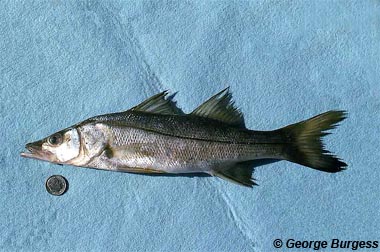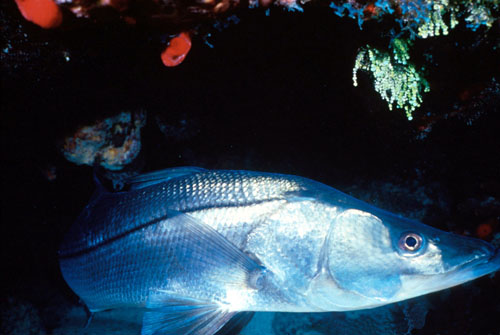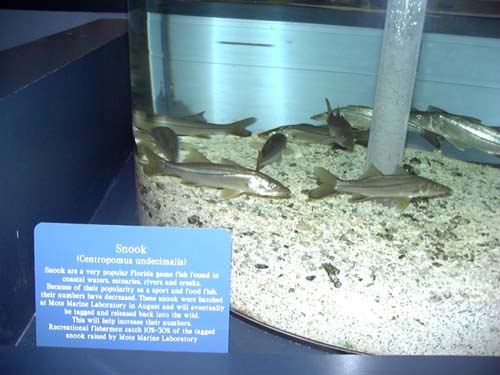
Centropomus undecimalis
These golden yellow fish have a very distinct black lateral line, sloping forehead, and protruding lower jaw. They are a very popular game fish that prefer near-shore vegetative habitats like river mouths and salt marshes, growing to over 40 inches long at times. These hermaphrodites change from male to female as they mature and their pelvic and caudal fins are noticeably more yellow during spawn.
Order – Perciformes
Family – Centropomidae
Genus – Centropomus
Species – undecimalis
Common Names
The English language common names for this species are common snook, linesiders, pike, sargeant fish, snook and thin snook. Other common names include chyk (Russian), alimindelig robalo (Danish), almindelig snook (Danish), bicudo (Portuguese), cambriacu (Portuguese), camburiacu (Portuguese), camorim (Portuguese), camorim-acu (Portuguese), camuri (Portuguese), camurim (Portuguese), camurim branco (Portuguese), camurim-acu (Portuguese), camuri-cabo-de-machado (Portuguese), camurim-preto (Portuguese), camurimpema (Portuguese), camuripeba (Portuguese), camuripema (Portuguese), cangoropeba (Portuguese), canjurupeba (Portuguese), esalho (Portuguese), falso-robalo-branco (Portuguese), rabalão, robalo (Portuguese), rabalo-bicudo (Portuguese), robalo-branco (Portuguese), robalo-camurim (Portuguese), robalo-de-galha (Portuguese), robalo-estoque (Portuguese), robalo-flecha (Portuguese), robalo-flexa (Portuguese), rolão (Portuguese), bima (Papiamento), sapat’i solda (Papiamento), snoekoe (Papiamento), binnensnoek (Dutch), snoek (Dutch), brochet (French), brochet de mer (French), crossie blanc (French), loubine (French), kamuli (Galibi), loubin gran lanmè (Creole, French), lubi (Palicur), pakiyau (Wayana), quéquere (Spanish), robalito (Spanish), róbalo (Spanish), robalo (Spanish), robalo blanco (Spanish), róbalo blanco (Spanish), róbalo común (Spanish), robalo (Swedish), signokou (Djuka), snoek (Sranan), snoekoe (Sranan), snook (German) and zuchwiak (Polish).
Importance to Humans
Common snook is a hugely popular recreational fish in the Gulf Coast due to its fighting ability and culinary value. The commercial harvest of common snook is prohibited throughout Texas and Florida (USA).
Conservation Status
Common snook are commercially exploited throughout most of their range except in Texas and Florida were they support a large recreational fishery. The Florida state legislation declared common snook a gamefish in 1957 and prohibited its sale. There has been no legal commercial harvest of common snook in Florida since this piece of legislation was enacted. Common snook is also commercially protected in Texas. In January 1999, the Florida Fish and Wildlife Conservation Commission implemented a slot limit, which means fish can only be recreationally harvested between the sizes of 26 to 34 inches (66 to 86 cm) in order to protect the larger breeding females. Common snook fishing is closed between December 15 and January 31 statewide in Florida and a bag limit of 1 or 2 fish per person per day depending on the area is strictly enforced (FWC fishing regulations). The common snook is not listed on the IUCN Red list.
> Check the status of the common snook at the IUCN website.
Geographical Distribution

Common snook are the most widely distributed species within the Centropomus genus and have been reported as far north as New York (USA) and throughout the Gulf of Mexico. Common snook are abundant along the Atlantic coast of Florida from Cape Canaveral south through the Keys and Dry Tortugas, and north to Cedar Key on the gulf coast. Common snook occur infrequently along the coast of Texas to Galveston and then more or less continuously south to Rio de Janeiro, Brazil.
Habitat
Juvenile common snook are generally restricted to the protection of riverine and estuary environments. These environments offer shallow water and an overhanging vegetative shoreline. Juvenile common snook can survive in waters with lower oxygen levels than adults. Adult common snook inhabit many environments including mangrove forests, beaches, river mouths, nearshore reefs, salt marshes and sea grass meadows. Adult common snook appear to be less sensitive to cold water temperatures than larvae or small juveniles. The lower lethal limit of water temperature is 48.2°-57.2° F (9°-14° C) for juveniles and 42.8°-53.6° F (6°-12° C) for adults.
Biology

Distinctive Features
Common snook have a slender body and a distinct lateral line. The dorsal fins are high and divided and the anal spines are relatively short. The common snook has a sloping forehead with a large mouth and a protruding lower jaw. Adult common snook can grow to over 47.24 inches (120 cm) in total length , which is larger than any other species in this family.
Coloration
Coloration of the common snook is golden yellow with a distinct black lateral line and pale yellow pelvic fins.
Dentition
The common snook lacks teeth on the maxillae. There is a band of fine teeth located on the premaillae and the dentaries. The palatine bone has a narrow band of teeth on it and the ectopterygoid bone located behind the palate may or may not have a tooth patch associated with it.
Size, Age & Growth
Common snook on the Atlantic coast of Florida commonly grow to larger sizes than common snook on the gulf coast of Florida. The largest observed sizes for females on the Atlantic and gulf coasts are 43.5 inches and 40.6 inches (110.5 and 103.2 cm) respectively. The world record for a common snook caught on hook and line is a 53-pound 10-ounce (24.28 kg) in Parismina Ranch, Costa Rica.
Theoretical longevity estimates from age and growth studies suggest that common snook can live to about twenty years old. On the Atlantic coast, the oldest sampled common snook was an eighteen-year-old female and the oldest male was fifteen. On the gulf coast, the oldest common snook sampled was a fifteen year old female and the oldest male was twelve.
Food Habits
Larval and small common snook eat mainly copepods and microcrustaceans. As common snook grow larger they eat fish, shrimp, crabs and zooplankton. This change in food habits occurs at around 1.8 inches (4.5 cm) standard length and continues throughout adulthood.

Reproduction
Common snook are protandric hermaphrodites, changing from male to female after maturation. This transition is identified by the presence of both male and female sex cells in the gonads and takes place when they grow to between 9.4-2.4 inches (24.0-82.4 cm) fork length which corresponds to 1-7 years of age. A study conducted in 2000, indicated that the sex ratios for common snook ages 0 – 2 are significantly skewed between the east and west coasts of Florida (USA) due to protrandry and differences in growth and mortality rates. The majority of small common snook are male and most large snook are female. Males reach sexual maturity during their first year at 5.9-7.9 inches (15.0-20.0 cm) fork length. Research shows that female gonads mature directly from the mature male gonads shortly after spawning. The probability that a common snook of a particular size will be a female increases with length or age.
Predators
The common snook are preyed upon by dolphins, birds including osprey and heron, and larger fish.
Parasites
Three species of myxosporeans [Myxobolus centropomi (trophozoites in gill, psuedobranch and under scales), Ceratomyxa choleospora (trophozoites and spores in gallbladder, spores in fecal casts) and Fabespora sp. (spores released in feces)] have been found to parasitize common snook in Florida.
Taxonomy
Bloch first described Centropomus undecimalis in 1792 in Jamaica. Synonyms include Sciaena undecimalis Bloch 1792, Centropomus undecim-radiatus Lacèpéde 1802, Perca loubina Lacèpéde 1802, Sphyraena aureoviridis Lacèpéde 1803, Centropomus appedniculatus Poey 1860 and Centropomus argenteus Regan 1904. The genus name Centropomus is derived from the Greek word “kentron” meaning to sting and the Greek “poma, -atos” meaning cover, operculum.
Prepared by: Michelle Press